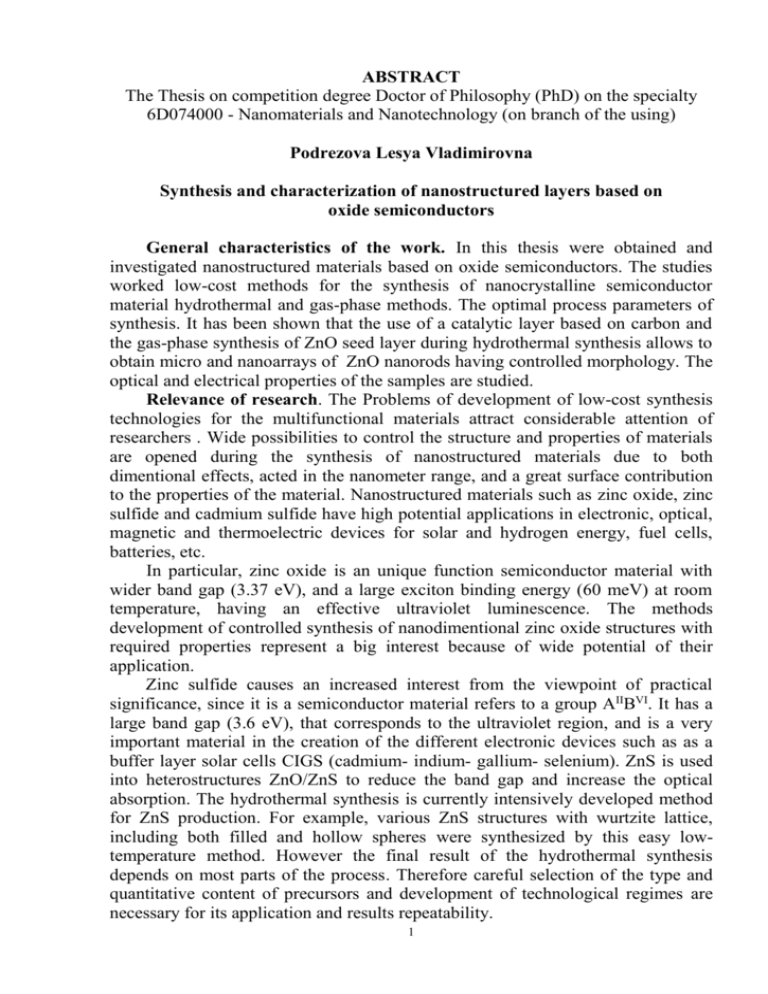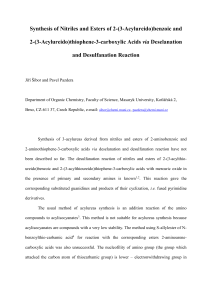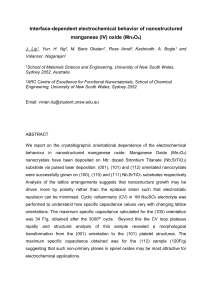ABSTRACT The Thesis on competition degree Doctor of Philosophy
advertisement

ABSTRACT The Thesis on competition degree Doctor of Philosophy (PhD) on the specialty 6D074000 - Nanomaterials and Nanotechnology (on branch of the using) Podrezova Lesya Vladimirovna Synthesis and characterization of nanostructured layers based on oxide semiconductors General characteristics of the work. In this thesis were obtained and investigated nanostructured materials based on oxide semiconductors. The studies worked low-cost methods for the synthesis of nanocrystalline semiconductor material hydrothermal and gas-phase methods. The optimal process parameters of synthesis. It has been shown that the use of a catalytic layer based on carbon and the gas-phase synthesis of ZnO seed layer during hydrothermal synthesis allows to obtain micro and nanoarrays of ZnO nanorods having controlled morphology. The optical and electrical properties of the samples are studied. Relevance of research. The Problems of development of low-cost synthesis technologies for the multifunctional materials attract considerable attention of researchers . Wide possibilities to control the structure and properties of materials are opened during the synthesis of nanostructured materials due to both dimentional effects, acted in the nanometer range, and a great surface contribution to the properties of the material. Nanostructured materials such as zinc oxide, zinc sulfide and cadmium sulfide have high potential applications in electronic, optical, magnetic and thermoelectric devices for solar and hydrogen energy, fuel cells, batteries, etc. In particular, zinc oxide is an unique function semiconductor material with wider band gap (3.37 eV), and a large exciton binding energy (60 meV) at room temperature, having an effective ultraviolet luminescence. The methods development of controlled synthesis of nanodimentional zinc oxide structures with required properties represent a big interest because of wide potential of their application. Zinc sulfide causes an increased interest from the viewpoint of practical significance, since it is a semiconductor material refers to a group AIIBVI. It has a large band gap (3.6 eV), that corresponds to the ultraviolet region, and is a very important material in the creation of the different electronic devices such as as a buffer layer solar cells CIGS (cadmium- indium- gallium- selenium). ZnS is used into heterostructures ZnO/ZnS to reduce the band gap and increase the optical absorption. The hydrothermal synthesis is currently intensively developed method for ZnS production. For example, various ZnS structures with wurtzite lattice, including both filled and hollow spheres were synthesized by this easy lowtemperature method. However the final result of the hydrothermal synthesis depends on most parts of the process. Therefore careful selection of the type and quantitative content of precursors and development of technological regimes are necessary for its application and results repeatability. 1 Recently application of the "ZnO nanorods/CuO nanoparticles» composites for photocatalytic hydrogen production from water solutions under the influence of solar lighting is very promising. Composites based on ZnO nanorods with CuO nanoparticles possess much higher photocatalytic activity in comparison with ZnO. Therefore high catalytic activity of composites can be used for creation of different type of chemical and gas sensors, for example, for detection of hydrogen sulfide, monoxide of carbon and other substances. The work function effectively reduces, and the emission current increases almost by tree times in CuO / ZnO composite materials. Therefore such materials are perspective for field emitters. The coreshell structures based on ZnO-CuO as application for optoelectronics and for the creation of flexible and low-cost solar cells, for solar cells with quantum dots attract great interest of scientists. The nanostructures based on ZnO-Ag, which can be obtained by rather simple hydrothermal route and electrodeposition, are widely researched last time also. ZnO-Ag structures possess the increased ability of photocatalytic degradation of many organic compounds that is highly demanded by ecology, environmental protection and as decontamination agent of harmful waste. ZnO-Ag composites show high antibacterial activity. Photoanodes, based on ZnO-Ag, possess the increased photoelectric sensitivity, and the ability to photo-induced decomposition of water. Because of large possibilities of practical application of oxide semiconductors and composite materials based on it the development of methods of their production and research of properties obtained samples are very actual. The Object of the study is nanostructured layers of oxide semiconductors and nanocomposites based on them. Subject of research is production methods and research of the semiconductor nanostructures properties for further applications in electronics. The thesis purpose is to develop synthesis methods of the nanostructured oxide semiconductor layers and nanocomposites based on it, allowing creating materials with desired morphology, electrical and optical properties. To perform a comparison between the different techniques of growth, to find the optimal mode for each of them. To analyze the properties of the samples, depending on conditions of the growth. To research synthesized samples using electron scanning microscopy, Raman spectroscopy, X-ray diffraction, atomic force microscopy to study the absorption and photoluminescence, electrical characteristics. The methodological base of the work is methods for nanostructured materials, such as hydrothermal synthesis, chemical vapor deposition method, solgel method, electrochemical deposition, vacuum thermal evaporation, etc. Scientific novelty of this study is to determine the technological growth conditions for the directed synthesis of semiconductor micro-and nano - crystalline samples of oxide semiconductors. Scientific and practical significance of the work. The obtained oxide semiconductor layers are very important material in the instrument (luminophors, detectors, light-emitting diodes, non-linear elements, etc.) can be successfully applied to create flexible and inexpensive solar cells, laser diodes. Homogeneous 2 arrays of zinc oxide nanorods and composites based on them are promising for the gas sensors, optoelectronic, piezoelectric nanodevices, field emitters, as well as the creation of the solar cell dye and quantum dots. Approbation of the work. The main scientific results of the thesis were published in 18 articles, 3 of them - in international scientific journals database SCOPUS (impact factor: 0, 0.600) and Thomson Reuters (impact factor: 1.545), 5 articles were published in journals recommended by accredited organ (2 articles in Bulletin of the KazNU and 3 in the Bulletin of KazNTU), 10 articles in the proceedings of the international scientific conferences. Presentations at 17 international conferences, 8 of them were foreign. There is an innovative patent for the invention of the RK 26062 04.11 2011 State. № 2011/1145.1 «A method for producing arrays of zinc oxide nanorods," copyright certificate number 74881. Scientific grant number 2675/GF3 "Development of methods for zinc oxide thin films for solar energy." The volume and structure of the thesis. The work consists on an introduction, three chapters, conclusion and list of used sources. The total volume of the dissertation consists of 115 pages. 3






